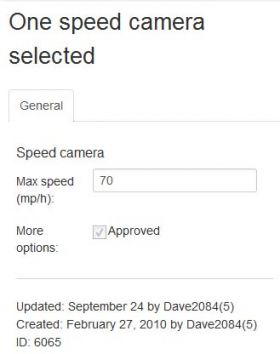| Line 20: | Line 20: | ||
|- valign="top" | |- valign="top" | ||
|[[Image:Icon_camera_redlight@2x.png|123px|top]] | |[[Image:Icon_camera_redlight@2x.png|123px|top]] | ||
|Red light camera locations of any type (Gatso or | |Red light camera locations of any type (Gatso, Monitron, RedSpeed or Level Crossing). | ||
Revision as of 21:19, 6 January 2014
Introduction
This page forms part of UK Editing Best Practice. Editors are encouraged to follow these guidelines.
Waze currently supports reporting of and warning for three categories of cameras: Speed Cameras, Red Light Cameras and Fake Cameras. This Wiki page aims to help the Wazer identify, map and approve cameras in the Client and Map Editor.
Waze Camera Types
Speed Cameras
Red Light Cameras
Fake Cameras
| Fake cameras should only be reported for a dummy camera i.e. one that is masquerading as a speed or red light camera as defined above. |
Reporting a Camera in the Client
To report a camera, press the report button at the bottom right hand side of the client screen. You will then be presented with the report Menu, from which you select "Camera".
All you need to do then is select the camera type and if it applies to your lane or the opposite one. Then simply press send.
 |
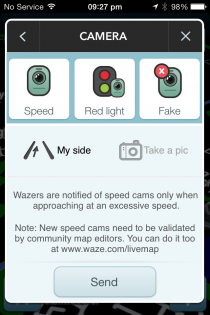 |
 |
Notes:
- The camera report will be placed on the map where you were when you pressed the "Report" button, so you can take your time to complete the other details as driving allows.
- The camera will only appear in the client after it has been approved in Waze Map Editor.
- Where a location has a camera in each direction, or it is reversible, two reports will be required.
Approving a Camera in Waze Map Editor
After a camera has been reported by a Wazer from the client, it will not appear on the live map until it has been approved in the Waze Map Editor. Before approval cameras appear in brown and once approved they change to grey.
| Unapproved | Approved | |||||
|---|---|---|---|---|---|---|
 |
 |
 |
 |
 |
 | |
(Note: The speed camera icons in the client do not have the old "30" logo as depicted still in Waze Map Editor)
Before approving a camera, the editor should exercise due diligence and investigate if there really is a camera at this location, being careful to rule out any duplicate(s) which has been reported and approved already. Many areas of the Waze map are flooded with cameras that are simply not out on the road. Use your judgement, if there is any doubt do not approve it but delete it.
Camera Placement
When reporting a camera from the Waze client it is not always possible to place it in the exact location required. Therefore, when approving a camera, the editor should examine clues on the map and aerial photography to assist in moving the camera to the correct position before approving it. You should be aware though that aerial photography (including road markings) and services such as Streetview are often out of date, so do not rely on them exclusively.
The identification guides for each camera type to be added to the Waze map aim to assist the editor in placing the camera in the correct position. Unfortunately every situation cannot be catered for in this guide so often the editor will have to use his/her judgement.
To move the camera select it and a circle will appear around it, the camera can then be moved anywhere in the circle. If it needs to be moved further then move it as far as allowed and save. Then use the "permalink" button at the bottom right of the editor screen to reload the page. Once reloaded the circle will be re-centred on the camera again, repeat until the camera is in the desired position.
 |
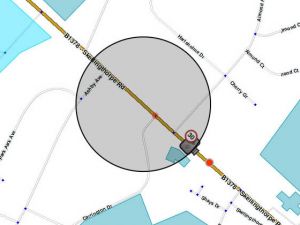 |
The red dot in front of the camera indicates the direction of travel and should be the same direction (facing the back of the car after it has driven past) regardless of camera type.
Note: A reversible camera will require two camera reports, one facing in each direction.
Setting Camera Speed and Approving the Camera
Notes:
- In managed traffic zones with variable speed limits the speed should be set to the maximum permitted speed. (e.g 70mph for the M42).
- Some red light cameras such as Monitron and RedSpeed are capable of recording speed limit violations as well as driving through a red light, however, the speed for all red light cameras should be set to zero so that you are always warned of their presence.
Removing an Approved Camera
An approved camera (grey), will only appear on the subsequent live-map update to its approval. If the camera is to be removed, there are two removal mechanisms available:
Waze Map Editor
An editor has the option of deleting approved and unapproved cameras from the map simply by highlighting it and pressing the delete key or the "Bin" button in the Editor. It should be noted however, that editors can only delete an approved camera if their editing rank is equal to or greater than that that of the editor who originally approved it.
Waze Client
When approaching a camera the user receives a caption warning them of the camera, this caption has a "Not there" button. Each time this happens the users editing rank is added to a running total. When the total is equal to or greater than the rank of the user who approved the camera then it becomes un-approved. At this stage anyone can delete it or it can be re-approved.
Cameras that should be reported
Gatso Speed Cameras
Gatso speed cameras are the most common speed camera type found in the UK and are rear facing, when triggered they will flash. They may be mounted on their own post (which may be reversible) or on an overhead gantry (common on motorway variable speed limit zones).
These cameras use radar to measure the speed of a vehicle and typically a series of markings is placed on the road in front of the camera, often on both lanes to catch drivers overtaking or driving on the wrong side of the road. These markings may also be behind the camera, this is a good indication of a reversible camera.
Where aerial photography is of good enough quality, it can be used to aid correct placement of the camera in Waze Map Editor.
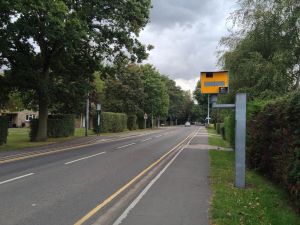 [Image by Dave2084] |
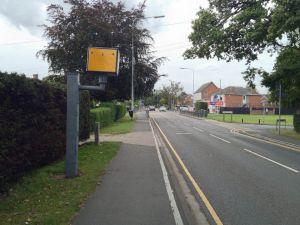 [Image by Dave2084] |
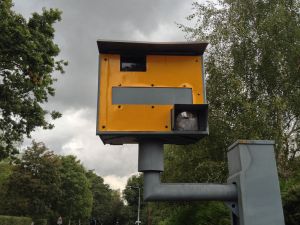 [Image by Dave2084] |
 [Image by Dave2084] |
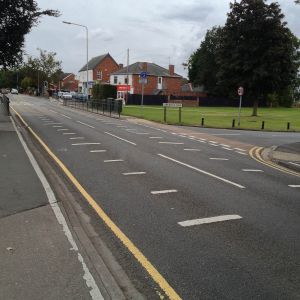 [Image by Dave2084] |
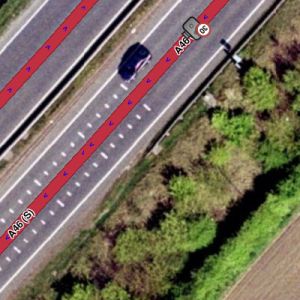 [Image taken from Waze Map Editor] |
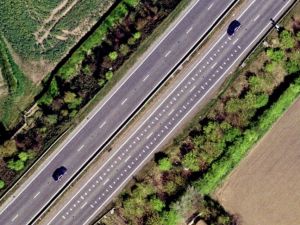 [Image taken from Waze Map Editor] | |
Gatso "Smart Pole" Speed Cameras
The Gatso Smart Pole is a new camera variant being deployed around the UK which uses the same technology as the standard digital Gatso cameras introduced in 2007 with a vandal resistant pole. As with the standard unit it is rear facing, and when triggered will flash.
Where aerial photography is of good enough quality, it can be used to aid correct placement of the camera in Waze Map Editor.
Take care not to confuse these cameras with Level Crossing Cameras which are similar in appearance.
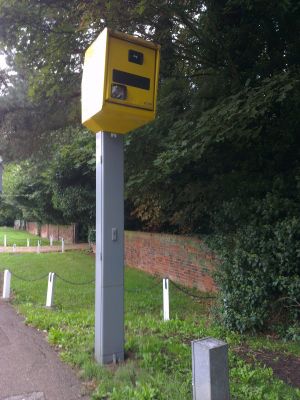 [Image by Twister-UK] |
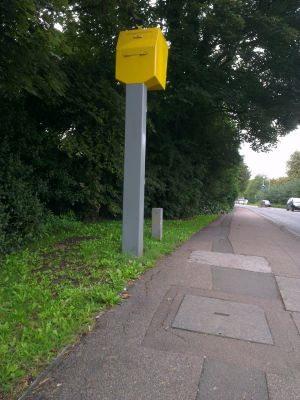 [Image by Twister-UK] |
Peek Speed Cameras
Peek speed cameras are similar to Gatso cameras in that they are rear facing and when triggered they will flash.
These cameras can use radar or sensors embedded in the road to measure the speed of a vehicle and typically no markings are painted on the road, though as older cameras are being upgraded to this new type of camera legacy markings may remain in the road.
Where aerial photography is of good enough quality, it can be used to aid correct placement of the camera in Waze Map Editor.
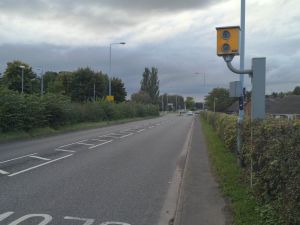 [Image by Dave2084] |
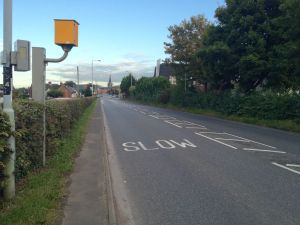 [Image by Dave2084] |
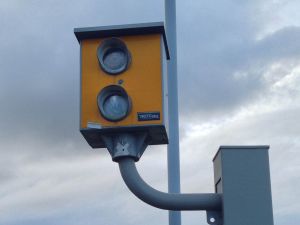 [Image by Dave2084] | |
Truvelo Speed Cameras
Truvelo cameras differ from Gatso and Peek cameras in that they are front facing, since they are Infra Red, when triggered you will NOT see any flash. They may also be configured in a rear facing arrangement although this is not common.
These cameras use sensors embedded in the road rather than radar to measure the speed of a vehicle and typically the road is marked with three white lines in front of the camera across one or both lanes. These markings may also be behind the camera, this is a good indication of a reversible camera.
Where aerial photography is of good enough quality, it can be used to aid correct placement of the camera in Waze Map Editor.
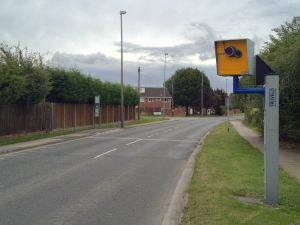 [Image by Dave2084] |
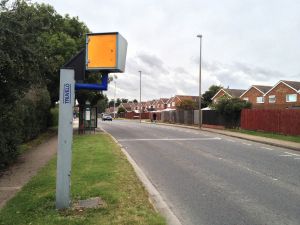 [Image by Dave2084] |
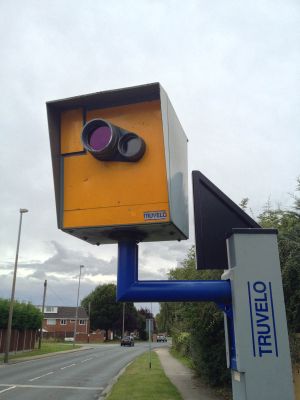 [Image by Dave2084] |
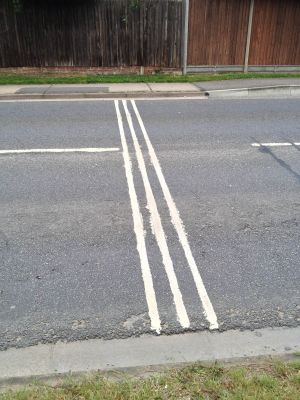 [Image by Dave2084] |
 [Image taken from Waze Map Editor] |
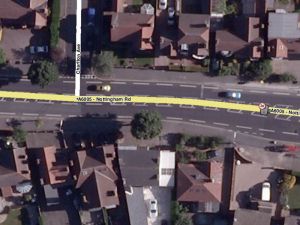 [Image taken from Waze Map Editor] |
Watchman Speed Cameras
Watchman cameras are quite unique among UK safety cameras in that they are an integrated system with a number of sensors comprising a speed warning board and a camera both with their own radar as shown below. At this time it is not clear if these cameras are type approved by the Home Office (and thus able to be used for prosecution).
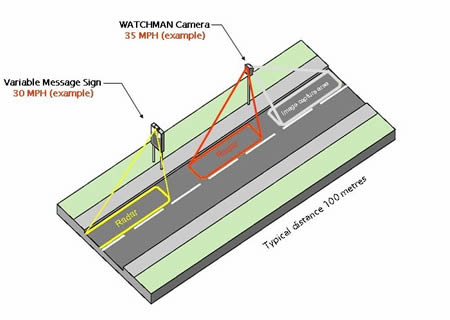
Where aerial photography is of good enough quality, it can be used to aid correct placement of the camera in Waze Map Editor.
 [Image by Dave2084] |
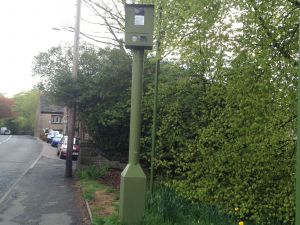 [Image by Dave2084] |
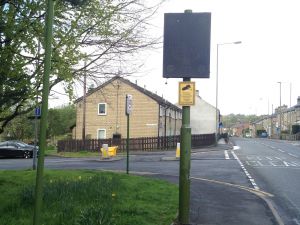 [Image by Dave2084] |
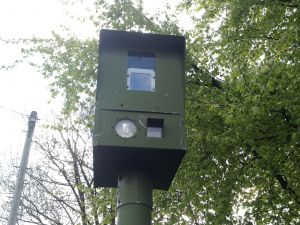 [Image by Dave2084] |
SPECS Average Speed Cameras
SPECS (SPEed Check Services) is a system that uses number plate recognition to measure the time taken between two fixed points to monitor a driver's average speed.
This is not a standalone system, a SPECS zone may consist of two or more cameras at entry point, mid point(s) and exit point of the monitored zone.
Due to the passive nature of this system no road markings are required.
Where aerial photography is of good enough quality, it can be used to aid correct placement of the camera in Waze Map Editor.
There are a number of camera types in use as shown in the images, however, the Type B SPECS cameras are now in use on overhead gantries on the approaches to the QE2 Bridge (Dartford Crossing) and M60 J26 Clockwise.
 [Image by Dave2084] |
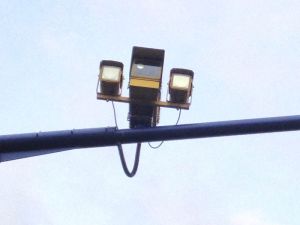 [Image by Dave2084] |
 [Image by Dave2084] |
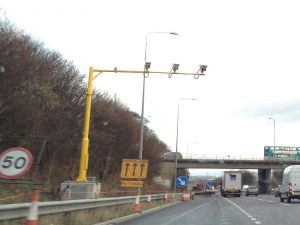 [Image by Dave2084] |
 [Image by Dave2084] | |
Monitron Speed and Red Light Cameras
Monitron speed cameras (sometimes referred to as SpeedCurb) are a new generation of digital cameras which can be configured as a speed AND/OR a red light camera.
These cameras use sensors embedded in the road rather than radar to measure the speed of a vehicle and typically no markings are painted on the road, though as older cameras are being upgraded to this new type of camera legacy markings may remain in the road.
Where aerial photography is of good enough quality, it can be used to aid correct placement of the camera in Waze Map Editor. If the camera is used as a red light camera then it should be placed on the stop line in Waze Map Editor.
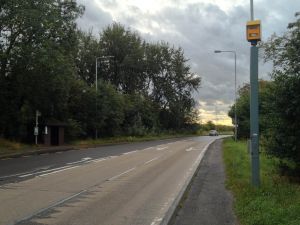 [Image by Dave2084] |
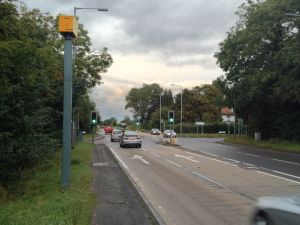 [Image by Dave2084] |
 [Image by Dave2084] | |
RedSpeed Speed and Red Light Cameras
These are new type of combined Speed and Red Light Camera.
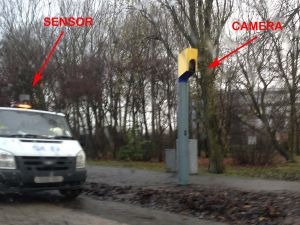 [Image by Dave2084] |
Gatso Red Light Cameras
Gatso red light cameras are different to their speed detection counterparts and will be triggered when driving through a red light.
These cameras use radar to measure the speed of a vehicle and do not normally have any markings on the road other than the stop line for the traffic lights.
When approving a red light camera in Waze Map Editor it should be placed on the stop line.
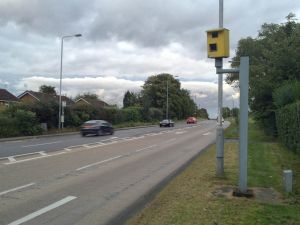 [Image by Dave2084] |
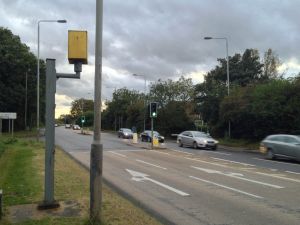 [Image by Dave2084] |
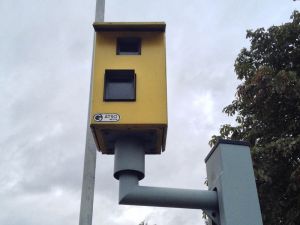 [Image by Dave2084] | |
Level Crossing Cameras
Take care not to confuse these cameras with Gatso "Smart Pole" Cameras which are similar in appearance.
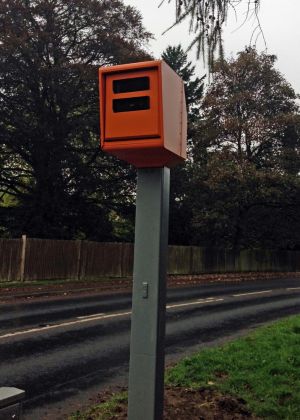 [Image by Moley_uk] |
Cameras that should not be reported
Mobile Speed Cameras
Mobile speed cameras should not be reported in Waze as by the time they are approved and appear in the client they will be long gone, instead use the Report -> Police feature in the client.
 [Image by Dave2084] |
Be aware when using Report -> Police to report a mobile speed camera that there have been recent cases of motorists being prosecuted for flashing their headlights to warn other drivers that they are approaching a mobile speed trap. Whilst there have been no recorded cases of a Wazer (or other App user) being prosecuted you could potentially be liable for prosecution for reporting in this way!
Trafficmaster
Trafficmaster has a network of 5,200 traffic flow monitoring sensors used to update their real-time traffic services on UK motorways and trunk roads. These sensors are not used for speed or red light enforcement and so should not be reported in Waze.
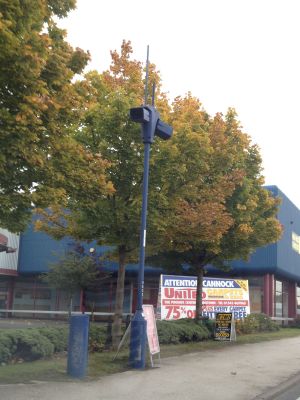 [Image by Dave2084] |
Congestion Charge Zone Cameras
The London Congestion Charge Zone (CCZ) uses cameras to record vehicles entering or leaving the zone, these are not used for speed or red light enforcement and so should not be reported in Waze.
[Images to Follow]
Automatic Number Plate Recognition
Automatic Number Plate Recognition (ANPR) cameras may be used for a number of enforcement functions including: Valid Tax, MoT Test, Insurance, Parking, Yellow-box violations and checking criminal activity. At this time however, they are not used for speed or red light enforcement and so should not be reported in Waze.
[Images to Follow]
Driver Feedback Signs
Electronic signs that warn you if speeding and may or may not tell you your speed.
[Images to Follow]
Camera Warning Signs
Signs that warn the drivers of possible cameras in the area should not be reported, even as a fake camera.
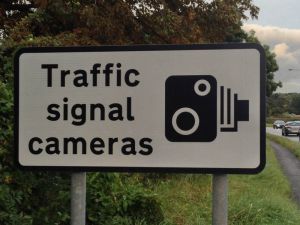 [Image by Dave2084] |
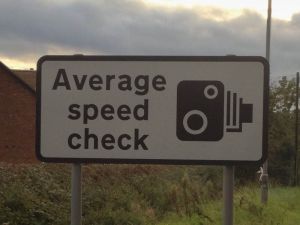 [Image by Dave2084] |
Page Feedback
If you have comments, suggestions or image contributions for this page please send me (Dave2084) a Private Message on the Waze Forums
« Back to UK Editing Best Practice
